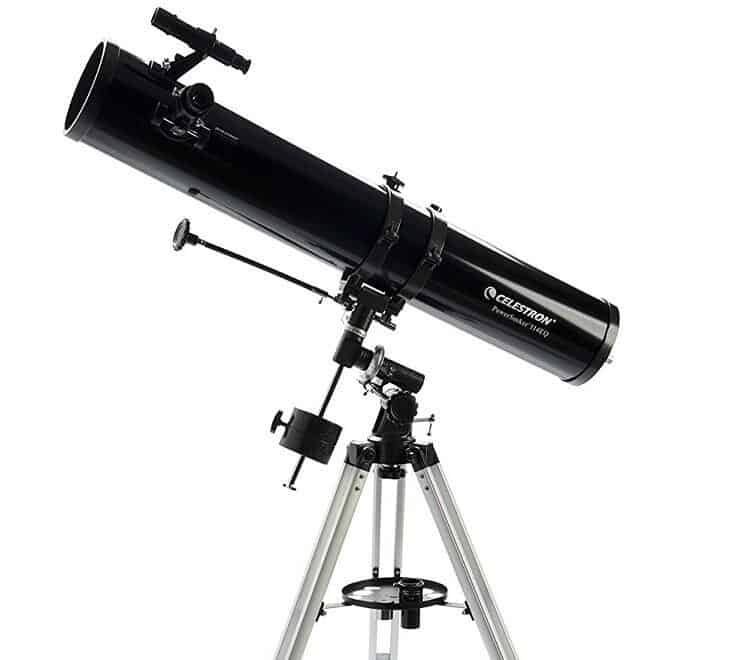Best Amateur Telescope Picks: The Ultimate Buying Guide
This post may contain affiliate links which could provide us a small commission for our work at no cost to you.
Read the full disclosure here.
Have you ever gotten excited by the news of an epic meteor shower or Blood Moon just to go outside and become disappointed by what you can see in the night’s sky? Without the right tools or a perfectly clear night, it can be hard to see astronomical wonders. If you have ever started and then given up on astronomy in the heat of frustration, you’re not alone. Luckily, we’ve got the solution. Invest in the best amateur telescope. Like many other hobbies, getting off to the right start is important. And we are here to help you do just that.
Are you ready for some serious stargazing? You should know that some telescopes are better-suited than others when it comes to clarity. When you begin shopping, there are several things that you should keep in mind. Below, we have listed a helpful guide to point you in the right direction as you shop for the best amateur telescope.

Best Amateur Telescope Reviews:
1. Orion 10015 StarBlast 4.5 Astro Reflector Telescope
The Orion StarBlast 4.5 is an outstanding choice for the best amateur telescope as well as for intermediate astronomers who can use its characteristics for the greatest extraterrestrial screening. It comes from the trustworthy Orion brand of telescopes, which is notorious for making high-quality scopes for astronomers of all skill levels.
While the telescope itself is difficult to use, but it also comes with several add-ons that can assist you in making the most from your telescope. Seasoned astronomers will even have the ability to make great utilization of the 4.5-inch aperture and stellar views of the nighttime skies.
The tabletop foundation on the mount that is altazimuth is, in addition, excellent as it is perfect for the backyard and allows for the simplest setup. The astronomy applications are easy enough for children to make use of and is also excellent to help beginners get started.
All in all, the StarBlast is a prime candidate if you seem to share with the family as well as kids. This isn’t just a kids’ telescope. It’s by no means a plaything, but it might help kids start their professions that are youthful astronomic.

The portability of the StarBlast 4.5 additionally makes it an excellent option if you plan on sharing it with family and friends. All in all, the Orion certainly will help anyone start to take pleasure in the marvels of astronomy, and has created an excellent option for the telescope for newcomers and families.
2. Celestron 21045 114mm Equatorial PowerSeeker Telescope
Here is another great pick for the best amateur telescope. With its 4.5-inch mirror is a great telescope that gives a lot for the cost. The Celestron PowerSeeker 114 collects three times the starlight than some other 60mm refractors. The bundle contains two eyepieces a plastic 3x Barlow PowerSeeker and a lightweight equatorial mount.
The PowerSeeker 114 holds its own against the Celestron FirstScope 114EQ. Using the K20 eyepiece on 45x enlargement, it’s not difficult to view its smaller satellite M32 and the Andromeda Galaxy.
Compared to 60-millimeter refractors, the PowerSeeker 114 shows a lot more detail in the Orion Nebula and reveals many more stars of Perseus Double Cluster and even brings some individual stars in globular clusters like M13 into view.

The Celestron guide right urges that most screening will be to 130x in the reach of 40x. As a result of this, higher magnifications are not worth the difficulty.
All in all, the Celestron PowerSeeker 114 is a low priced telescope with great optical performance, particularly when using the low power K20 eyepiece.
3. BARSKA Starwatcher 400x70mm Refractor Telescope
There is no uncertainty the BARSKA Starwatcher 400x70mm is made for adults and children looking for their initial scope, considering its low cost.
Two eyepieces are included – a 1.25″ K9 eyepiece and 1.25″ K20 eyepiece. These eyepieces supply 100x and 20x magnification. As said, this is great to see the rings on Saturn, along with the Moon in sharp detail and groups on Jupiter along with their moons, which ought to get your child or yourself farther interested in astronomy.
Its scope weighs only 4.4 lbs. And is quite streamlined, making it perfect for traveling and is light enough for children to go and use without any help.
The Starwatcher can be utilized for terrestrial viewing due to its 45 degree diagonal, which ensures that pictures are non-inverted and not seen upside down.
You can not expect much in this price range, but first-time astronomers will be happily surprised with the ability to see the Moon and as far as Saturn and its moons of the scope. The scope has a few other things going for it also, which might allow it to be preferable for newbies in comparison to other versions that are low-cost.
There is no uncertainty the BARSKA Starwatcher 400x70mm Refractor Telescope offers outstanding value for money. For well below $100 you’re obtaining a scope that is very simple use features great optics, may be taken with you as you travel, comes with useful applications including a carrying case, and is backed by a very long time guarantee.
What You Should Know When Choosing the Best Amateur Telescope
When you begin to shop for the best amateur telescope, it is important to keep realistic expectations. Choosing the right telescope involves a good deal of time and effort. While it may be tempting to opt for the telescope with the flashiest package or marketing tactics, this is often not the best investment. You don’t need to break the bank to find a good model. When using any type of telescope, it is important to read the instructions and manual in order to make the most of its abilities. With the right knowledge in your toolbelt, you will be well on your way to purchase the best amateur telescope. You will be stargazing in no time! Read the following information so you can understand out what to look for.
Types of Telescopes
Reflector Telescope
Have you ever heard of a reflector telescope before? These models use mirrors to gather light and divert the mirrored image so it can be seen by the human eye. The first reflector telescope was born when Isaac Newton attempted to capture the Halo Effect. While the original design was anything but sleek and modern, today’s designs are slim and popular.
Reflector telescopes have internal mirrors that capture an image and reflect it in a telescopic lens. When practicing astronomy, this is the model that you want. A secondary mirror is located in front of the primary mirror. This captures the reflection from the primary mirror and reflects the image in the viewing lens. You will find that these types of telescopes have superb focusing abilities through light gathering and reflection. Viewers are able to obtain clear, bright images of star clusters far off that they would not otherwise be able to see. The only downside of using a reflector telescope is that the reflective secondary mirror sometimes blocks a small amount of light.
Refractor Telescope
This was one of the first types of devices used by those in history who craved to see the galaxy beyond that of the naked eye. The compound telescope was invented by combining the qualities of the reflector and refractor telescopes. The same types of glass employed in spyglasses were produced on a grand scale and used for the refractor telescope. Prized for its ability to refract light, these telescopes are helpful to pull in clear images.
By amplifying a glass lens, a refractor telescope provides improved focus. As light moves through the lenses and through the length of the telescope, it is bent. The bent light passes through a smaller lens, called the eyepiece. Then, the image is produced before the viewer’s eyes. The lens accessories provide several focus range capabilities. Every lens offers an enhanced range of focus. So, you can view far off objects with great focus and clarity. However, like most tools, the refractor telescope has some disadvantages. One of the most common is that incoming light bends and is not filtered, creating some colorization. With this said, it still provides a very clear image and the minimal colored specks that occur rarely interfere with telescopic imagery.
Aperture
Among the essential and main aspects to remember when purchasing the best amateur telescope is its aperture. It is fundamentally a name given to the diameter of the primary optical element of the telescope, like that of a mirror or a lens. It’s true that the larger the aperture is, the better would be.
That’s due to the reality that a larger aperture will mean a larger surface area, letting it accumulate a greater quantity of light compared to the telescope with smaller apertures.
The fundamental aim of the aperture is the fact that it’ll determine the gathering of light as well as the resolution. The power of light assembly will affect the brightness of the resultant picture. Resolution denotes the sharpness of the picture. Recreational telescopes that are great will produce apertures that are large, allowing with the necessities of the user.
Magnification
There’s an overall misconception when folks inquire a telescope can magnify. For being great or not they often refer to magnification as the standards of a telescope. But in reality, it is entirely up to you how much you would like to magnify, determined by the eyepiece you choose to use.
There should be an optimum magnification kept stopping the spread of the light to glowing things, getting them to glaze over and to see the things clearly. Astronomers, so, generally favor low magnification power for faint objects, like galaxies and nebulae. Medium to high power places to see things such as planets and the moon.
An excellent telescope would provide optimum magnification that’s medium for vibrant bodies and less for dim bodies without making them glaze over.
Magnification vs. Aperture
The scope has a focal length. The focal length is the distance from the main lens. Determined by the range and the kind of aperture, focal length large number are normally printed on the rear of the scope or the front. It typically ranges between 400 to 3,000 millimeters.
Ensure that you’re trying to find the quality of aperture diameter as opposed to the magnification when choosing a telescope.
Final Review: The Best Amateur Telescope
We hope you enjoyed reading our article on the best amateur telescope picks. Now that you understand the basics of telescope types and their functions, you know what to look for in your search. Make sure to take your time, read plenty of customer reviews, and stick to your budget. Happy stargazing!
